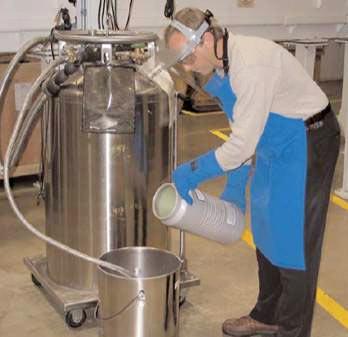Frostbite during handling of liquid nitrogen: prevention and first aid
(Animal Breeding Group, NDDB, Anand)
During cryopreservation of semen, Liquid Nitrogen (LN) (having a boiling point of -1960C) is handled extensively. If proper care is not taken, there is every possibility of getting frostbite. Even the vapour arising from liquid nitrogen is capable of producing frostbite if exposed for longer duration. If the exposed skin turns pale or red (patches) and is very cold, hard or waxy looking, it may be frostbite. There are chances of experiencing a prickling feeling or numbness. Severe or deep frostbite may result in blistering and pain. In extreme cases, it may damage the muscles, tendons and nerves permanently.
Following preventive steps would be beneficial to avoid frostbite during semen processing and handling –
- Create awareness and impart knowledge about safe handling of liquid nitrogen to the staff associated.
- Wear cryo gloves during handling liquid nitrogen.
- Wear protective clothing and shoes to avoid liquid nitrogen contact with body and feet.
- Secure the liquid nitrogen tank properly during transport.
- Liquid nitrogen should be handled in such place where it is easy to escape
- While pouring liquid nitrogen from one container to another, proper precaution should be taken to avoid spillage and contact with skin. It is better to use LN Transfer Device for transferring LN instead of pouring. This can also help to reduce wastage of LN.
- The habit of leaning in to the bulk semen storage container for seeing the straws should be avoided to avoid injury to eyes and uncovered body parts.

|
Figure1: Safety measures during LN handling Photo Source: www.sjsmith.com |
If a person gets frostbite by accidental exposure to liquid nitrogen, following first aid should be given and the person should be sent to nearest medical facility for further treatment and care –
- The person should be brought to a warm place and covered with warm clothes to counteract hypothermia, if any.
- The frostbite site should be dipped in warm water (37-420C) till sensation returns to the affected part. Hot water should be avoided for this purpose.
- The affected area should be covered with clean dry cloth. Wrapping with wet cloth should be avoided.
- Warming the affected body part using direct heat like lamp, fire place or heating pad should be avoided.
- Rubbing the affected part should also be avoided, as the skin gets loose during frostbite and may get peeled off.
- The person must be brought to medical attention as early as possible for proper care and specific treatment.

|
Figure 2: Ways to safe handling of Liquid nitrogen and first aid during cryo injury |
Prepared by Dr S S Layek, Deputy Manager (AB), NDDB, Anand
